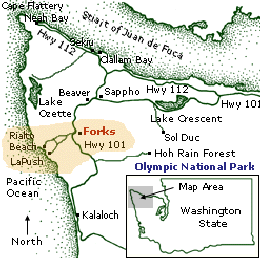In May 1792, Mexican and Spanish settlers commanded by Salvador Fidalgo complete a settlement at Neah Bay near the northeastern tip of the Olympic Peninsula. Explorer Manuel Quimper had claimed the bay and named it Nuñez Gaona on August 1, 1790. The new settlers plan to stay for the long term, making this the first European settlement in present-day Washington intended to be permanent. However, it is in fact only briefly occupied before Spain retreats from the Pacific Northwest under threat of war with Great Britain.
Following Hezeta's Footsteps
Spanish sailors commanded by Bruno de Hezeta became the first Europeans to land in the future state of Washington on July 12, 1775, when they came ashore at Grenville Bay on the Olympic Peninsula's Pacific shoreline and claimed "Nueva Galicia" for Spain. However they quickly departed after Quinault warriors slew a seven-man shore party.
Spain established its first settlement in the Pacific Northwest at Nootka Sound, on Vancouver Island, in 1789. The estuary had first been charted and claimed by Juan Perez in 1775, but English, Russian, and American fur traders ignored Spain's claim to sovereignty over all of the Pacific and used the bay as a trading center. Spain claimed that this sovereignty had been granted by papal decree in 1493, confirmed when Spanish explorers formally took possession of the area. Britain claimed that possession could only be established by actual occupation.
Not So Friendly Cove
Spanish Captain Esteban Jose Martinez arrived at Nootka Sound's "Friendly Cove" in 1789 and attempted to assert Spanish control by seizing four ships owned by English trader John Meares and associates. Captain John Colnett and his crew were taken prisoner. (Meanwhile, Martinez also hosted and aided the American trader Robert Gray.) When news of the "Nootka Insicent" reached London, Britain threatened war and Spain signed the Nootka Convention on October 28, 1790, abandoning its exclusive claims to the region and sharing Nootka Sound with all nations.
Due to slow travel and Spain's penchant for secrecy, news of the concession was slow to reach its American colonies. Quimper had already left Mexico to establish a permanent base and explore the inland waters of Vancouver Island in 1792 when British Captain George Vancouver arrived to enforce the terms of the Nootka pact. That same year, Spanish expeditions led by Jacinto Caamano, Alcala Galiano, and Cayetano Valdes charted the coastline from Washington to Alaska on Spain's last voyages of discovery in the Pacific Northwest.

